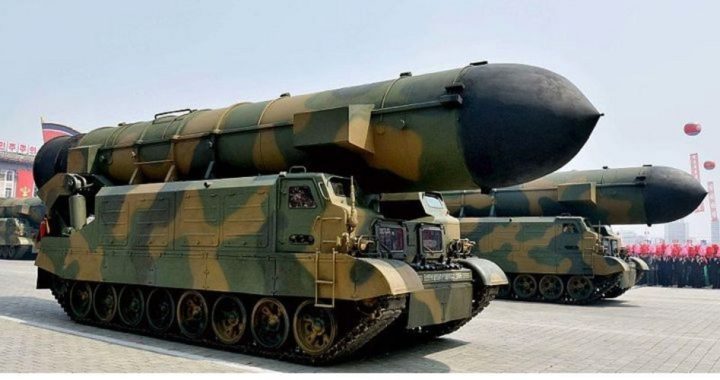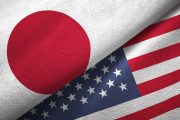
North Korea’s state-run KCNA news agency reported on May 22 that the communist state had conducted a test launch of a medium-range, solid-fuel Pukguksong-2 missile (shown) the previous day. The missile flew about 500 km (310 miles), reaching an altitude of 560 km (347 miles), before landing in the Sea of Japan.
The test verified technical aspects of the weapon system and examined its “adaptability under various battle conditions” the KCNA report stated.
The communist nation’s dictatorial leader, Kim Jong-Un, oversaw the missile test and reportedly “approved the deployment of this weapon system for action” and said that it should “be rapidly mass-produced.”
“It feels grand to look at the Earth from the rocket we launched and the entire world looks so beautiful,” KCNA quoted Kim as saying.
Bloomberg reported that this was North Korea’s eighth such missile test this year, and the second since Moon Jae-in won South Korea’s presidential election on May 9. President Trump has vowed to stop North Korea’s development of a missile that could deliver a nuclear warhead to North America, using force if necessary.
The Qatar-based Al Jazeera news network reported that the United States, South Korea, and Japan sharply denounced the launch and jointly requested an emergency meeting of the United Nations Security Council, which will be held on May 23.
That report also noted that solid fuel missiles — such as the Pukguksong-2 — offer advantages for military use because the fuel is more stable and can be transported easily in the missile’s tank, allowing for a launch on very short notice.
Liquid-fuel missiles, in contrast, are fueled at the launch site in a process that can take up to an hour, making them easier to spot and destroy than the solid-fuel variety.
KCNA reported that the launch verified the reliability and accuracy of the solid-fuel engine’s operation and stage separation and the late-stage guidance for a nuclear warhead, information that was recorded by a device mounted on the warhead.
A May 22 Reuters report cited Secretary of State Rex Tillerson’s statement that economic and diplomatic pressure against North Korea would continue in the wake of the missile testing.
Reuters also quoted Japan’s chief cabinet secretary, Yoshihide Suga, who said the day after the launch: “We cannot absolutely tolerate the missile launch on May 21 and repeated provocative remarks and actions by North Korea. It is important to lower North Korea’s foreign currency earnings and prevent nuclear missile related shipment and technological transfer in order to prevent North Korea’s nuclear missile development. We will fully implement our own sanctions against North Korea.”
The test-firing of the Pukguksong-2 came just one week after North Korea launched a Hwasong-12 intermediate-range missile, which according to Pyongyang was capable of carrying a “heavy” nuclear warhead. A May 15 NBC News report noted that, in a unanimously agreed statement issued that day, the 15-member UN Security Council had condemned North Korea’s recent ballistic missile tests, calling for a “sincere commitment to denuclearization through concrete action and stressed the importance of working to reduce tensions.”
“To that end, the Security Council demanded the Democratic People’s Republic of Korea conduct no further nuclear and ballistic missile tests,” the council said, adding that it was ready to impose further sanctions on the country.
In an article posted that same day, The New American reported the previous day’s announcement from KCNA that the communist regime had fired a new ballistic missile, which reached an altitude of 1,312 miles and covered a lateral distance of 489 miles. Missile experts observed that if the same missile were to be launched at a standard trajectory, it would have a range of at least 2,500 miles, enabling it to reach the U.S. base at Guam.
Following the May 14 North Korean missile test, White House Press Secretary Sean Spicer issued a statement, noting:
North Korea has been a flagrant menace for far too long. South Korea and Japan have been watching this situation closely with us. The United States maintains our ironclad commitment to stand with our allies in the face of the serious threat posed by North Korea. Let this latest provocation serve as a call for all nations to implement far stronger sanctions against North Korea.
Our reaction to that statement was that most Americans would probably be more reassured if our government would work at perfecting a better anti-ballistic missile (ABM) system that could intercept any North Korean missiles fired in our direction, instead of placing our hopes on sanctions. Many sanctions have been leveled against Pyongyang in recent years, and they have not deterred that communist regime from engaging in a steady stream of tests of both ballistic missile and nuclear weapons.
At present, the only system capable of intercepting North Korean missiles is the Ground-Based Midcourse Defense (GMD) located at interceptor sites at Fort Greely, Alaska and Vandenberg Air Force Base, California. However, as North Korea increases the range and accuracy of its medium range missile and eventually develops Intercontinental Ballistic Missiles (ICBMs), the reliability of these systems will need to be improved. As of June 2014, only nine of the 17 (53 percent) hit-to-kill intercept tests have succeeded. In response to these less-than-acceptable results, the Pentagon is asking for a budget increase and another test for the fielded program.
An April 5 report in the Los Angeles Times quoted a statement from the Government Accountability Office, a nonpartisan investigative arm of Congress, which reported last year that GMD’s test record has been “insufficient to demonstrate that an operationally useful defense capability exists.” In July, a team of missile defense experts who studied GMD for the Union of Concerned Scientists said the system is “simply unable to protect the U.S. public.”
In January, continued the Times report, the Pentagon’s Operational Test and Evaluation office, in its annual report on U.S. defense programs, rated GMD’s reliability as “low.” It said the day-to-day “availability,” or readiness, of the system’s interceptors was also “low.” The report added that flight tests had revealed unspecified “new failure modes.”
If these reports are correct, then our nation obviously needs a better GMD system, and it needs it sooner rather than later. Sanctions will do nothing to protect us.
Photo of ballistic missile: LionFlyer
Related articles:
North Korea Tests Ballistic Missile Capable of Reaching U.S. Base on Guam
North Korea Threatens U.S. With “All Out War” and “Weekly Missile Tests”
North Korea’s Letter to Congress Says Pyongyang to Speed Up Nuke Program in Response to Sanctions
As N. Korea Celebrates Anniversary of Military, S. Korea Is on Alert
North Korea Threatens to Attack U.S. Carrier Group; Detains U.S. Citizen
Russia Says Troop Movement Near North Korean Border Was Scheduled
North Korea Warns of Nuclear Retaliation at Any Sign of U.S. “Aggression”
North Korea Admits Missile Launches Were Test of Possible Strike Against U.S.Bases in Japan
North Korea Missile Test Draws Reactions From Trump, Abe, and UN
North Korea Claims to Test H-Bomb
North Korea Postures With Nuclear Warning, Movement of Missiles



